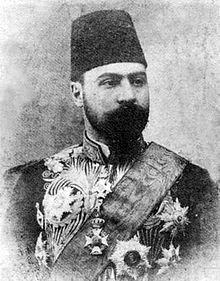Hassan Pirnia
| Hassan Pirnia | |
|---|---|
 |
|
| Prime Minister of Iran | |
|
In office 14 March 1915 – 1 May 1915 |
|
| Monarch | Ahmad Shah Qajar |
| Preceded by | Mostowfi ol-Mamalek |
| Succeeded by | Abdol Majid Mirza |
|
In office 3 July 1920 – 27 October 1920 |
|
| Monarch | Ahmad Shah Qajar |
| Preceded by | Vossug ed Dowleh |
| Succeeded by | Fathollah Khan Akbar |
|
In office 21 January 1922 – 22 June 1922 |
|
| Monarch | Ahmad Shah Qajar |
| Preceded by | Ahmad Qavam |
| Succeeded by | Ahmad Qavam |
|
In office 15 June 1923 – 26 October 1923 |
|
| Monarch | Ahmad Shah Qajar |
| Preceded by | Mostowfi ol-Mamalek |
| Succeeded by | Rēzā Pahlavi |
| Personal details | |
| Born | 1871 Nain, Persia |
| Died | 1935 Tehran, Persia |
| Political party | Moderate Socialists Party |
| Religion | Twelver Shia Islam |
Hassan Pirnia (Persian: حسن پیرنیا ; 1872–1935) was a prominent Iranian politician of 20th-century Iran. He held a total of twenty-four posts during his political career, serving four times as Prime Minister of Iran. He was also a historian, co-founding the Society for the National Heritage of Iran.
Hassan was the eldest son of Mirza Nasrullah Khan, a Prime Minister during the Qajar era. Hassan also had a younger brother named Hossein, who served as speaker of the Parliament of Iran.
Hassan became Iran's Minister to the Russian Court before returning to Iran, where he founded the Tehran School of Political Science in 1899.
Upon his father's death, he assumed the title of Moshir al Dowleh, playing an important role in drafting the Persian Constitution of 1906. Hassan was given an Honorary Knight Grand Cross of the Order of St Michael and St George by the British crown in 1907. From 1907 to 1908, Pirnia was the Minister of Foreign Affairs, during which time he declared the Anglo-Russian Entente, which would divide Iran into zones of imperial influence, as null and void. He later became Minister of Justice before becoming Prime Minister for the first time in 1915. He would re-assume the office in 1920, and again in 1922 and 1923. One of Pirnia's key actions during his time as Prime Minister saw him prevent the introduction of the Anglo-Persian Agreement of 1919.
Following his retirement, he published a three-volume history of pre-Islamic Iran, entitled Tarikh-e Iran-e Bastan (History of Ancient Iran). An abridged version, Tarikh-e Mukhtasar Iran-e Qadim, published in 1928, became a standard textbook for students. Hassan's other significant contributions to the cultural life of Iran included helping to set up an Institute for the Preservation of National Heritage along with Abdolhossein Teymourtash and Mohammad Ali Foroughi in 1922.
...
Wikipedia
